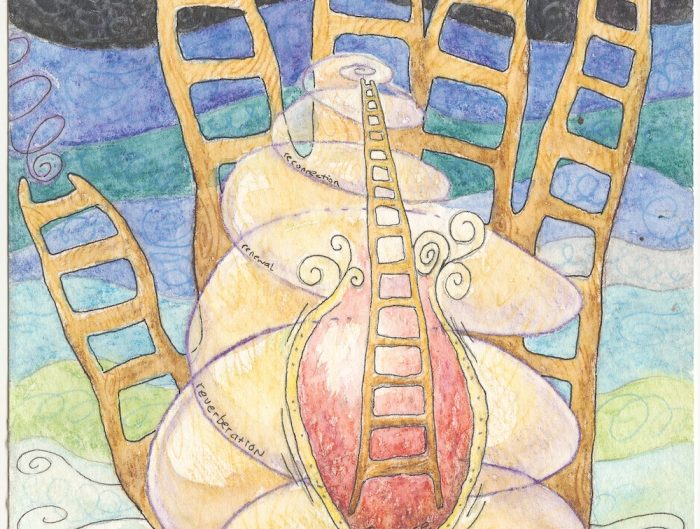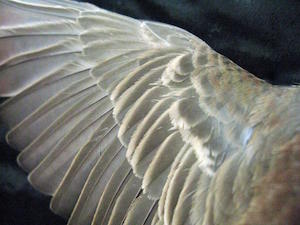 “In the end, all collaborations are love stories.” Twyla Tharp, The Collaborative Habit: Life Lessons for Working Together (Simon and Schuster, 2013, with Jesse Kornbluth)
“In the end, all collaborations are love stories.” Twyla Tharp, The Collaborative Habit: Life Lessons for Working Together (Simon and Schuster, 2013, with Jesse Kornbluth)
They say certain angels are assigned to fuss over brides on their wedding day to ensure perfection on all fronts (from corset seams to seating charts to weather) and I’d say an equally powerful set of trickster angels—or coyotes—oversee the creative process, promising detours and unexpected outcomes. But also ushering in companions of like mind and opening doors in a coincident way, bringing exactly what one craves to finish the project whether songwriting, collaging, blogging or filming. Poet Michelle Bitting talks about this in The Muse and The Making of Poetry Videos.
When you join forces with a collaborator, that coincident factor (and posse of coyotes) more than doubles under the power of two visions and two skill sets. I experienced this when I answered Liz Brennan’s call at Perhaps, Maybe for prose poetry collaborators. Strange Attractors: Absence of Presence and a Choice of Wings tracks how the phrase “three winged bird” led us to an actual image of three nested golden wings that appears on the cover of Leadership and The New Science by Margaret Wheatley (about institutions and the need for new collaborative processes). Liz’s open call to poets who wish to respond to a Perhaps verse with a Maybe verse and vice versa affords her the opportunity to play with many different writers and leave behind a trail of new poems in her wake.
Another collaborative permutation can be found in team blogging. At The Pirate Tree, J.L. Powers assembled a panel of young adult writers to blog about children’s literature and social justice. The Mission statement describes the impetus behind the blog title’s image, “The Pirate Tree comes from a picture book that Lyn Miller-Lachmann once wrote about two children whose grandfathers fought on opposite sides of the war.” Forbidden to play together, the children discover a way to play anyway, using the branches of a tree arching over both yards. Using that image as a touchstone, the blog focuses on “books and writers that question and rebel against the status quo, argue for peace and reconciliation, take the side of the marginalized and powerless, and use creative solutions to overcome obstacles.” (Another title analysis slip! More here on titles and blog subtitles).
Back to team blogging: you share the burden of blogging as well as diversify your content. And your potential readership grows according to the attractant power of each contributor. Just scanning the list of books written by the team makes me want to see what they have to say in their reviews of the work of others: Ann Angel, author of Janis Joplin, Rise Up Singing, Nancy Bo Flood, Warriors in Crossfire, Varian Johnson, Saving Maddie, E. M. Kokie, Personal Effects (“on competing visions of masculinity in shadow of conflict of Iraq”), Lyn Miller-Lachman, Gringolandia, Peter Marino, Magic and Misery, and J.L. Powers, This Thing Called the Future (“a coming of age novel set in post-apartheid South Africa”).
Then there are internal collaboration blogs, or what I think of as synthesis blogs where a blogger draws on two aspects of personal interest. Such as yoga and poetry. Poet Leza Lowitz runs Sun and Moon Yoga Studio in Tokyo and greets visitors to her site with a poem that begins: “Across cultures, across genres / The wisdom of the heart / The poetry of the body…” Lowitz writes about both subjects (yoga and poetry) as well as her connection to Japan on her Red Room blog. She joins forms as well in her book: Yoga Heart, Lines on the Six Perfections described on her site as “meditative poems on the Buddha’s six qualities for a meaningful life—generosity, kindness, patience, joyful effort, stillness, wisdom….written over years of ‘Everyday Zen’ practice, inspired by nature, meditation, yoga, Zen, Buddhism” and more.
Page Lambert combines her two passions, Nature and Writing. Her blog’s tagline reads: All Things Literary. All Things Natural. An upcoming workshop is titled, “Literature and Landscape of the Horse.” A line from her course description reads, “What can ‘Natural Horsemanship’ teach us about ‘writing what the body knows’ instead of relying on the intellect?” From Lambert’s synthesis, I am inspired to consider diverse areas of interest in my life that might lend themselves to co-teaching or co-blogging. Great way to double your joy.
Lest we stray too far from poetry, let’s talk about poet/photographer Rachel Eliza Griffiths (whose poetry collection, Mule and Pear was chosen for the 2012 Inaugural Poetry Award by the Black Caucus American Library Association). Scroll through her header photos until you find that stunning image of Griffiths a la Two Fridas (by Frida Kahlo), typewriter and camera standing in for her two selves. I can’t help but hold the image of Frida’s bared heart in mind as I take in the dually powerful and unflinching gaze of Griffiths with her tools at hand. I love the visual synthesis of two selves as well as the way she uses word play in a number of her photos.
And while Joyce Tenneson may not be blogging with words, her portfolio on-line creates a visual postcard blog I had to mention because of this line in her bio: My camera is a witness. It holds a light up for my subjects to help them feel their own essence, and gives them the courage to collaborate in the recording of these revelations. To do the metaphor justice, one could say when we collaborate on the Web, we use the blog as witness. Here in Tenneson’s world, the photographer and the subject of the photograph are collaborating via the medium of camera, since photos reveal something about the one photographing as well as the one photographed.
Tenneson’s categories, like those of Julie Heyward from last week’s Inquiry Posts, Chaucer and Blogger as Pilgrim delight: A Life in Photographs, Amazing Men, Flower Portraits, Light Warriors, Intimacy, Wise Women, Transformations. What arrived in my inbox last week was an image from the Light Warrior series that had formerly appeared on the cover of The Sun. An angel of sorts with her wistful eyes, light bursting from the chest, the black draped sleeves sliding off her open hands and arms extended at each side. And midchest, half of a set of wings—extended like they would be in flight over her hidden heart—fringed with a silvering light.
End Notes and Further Inquiry:
Heart Photo and Original Artwork: Robyn Beattie
J.L. Powers of The Pirate Tree also runs The Fertile Source and is my co-colloborator at Mother, Writer, Mentor.
VIDA: Women in the Literary Arts, blog Her Kind, hosts conversations between women writers around a common question. Here’s one featuring Rachel Eliza Griffiths.
For more on the Two Fridas: Frida Kahlo: Identity/Duality by Amie R. Gillingham
For more on Margaret Wheatley: The New Science of Leadership: An Interview with Margaret Wheatley by Scott London. See also her book, a simpler way written in collaboration with Myron Kellner-Rogers. Visit her site for a full list of books she has written.
Thanks to President and Founder Darlene Chandler Bassett of A Room of Her Own Foundation for recommending Twyla Tharp’s books (on the heels of my presentation for the Summer 2011 retreat, Female Power in the Face of Adversity: Collaboration as Excavation based on micro-movies made with Robyn Beattie). Tharp’s The Creative Habit: Learn it and Use it for Life A Practical Guide (Simon and Schuster, 2005, with Mark Reiter) has wonderful inventory exercises designed to help articulate goals and identify blocks. The Collaborative Habit: Life Lessons for Working Together contains further exercises meant to help orient and align prospective collaborators with one another. Chapter titles include: Collaboration is Second Nature, Partnerships Challenge and Change You and Working with a Remote Collaborator.



